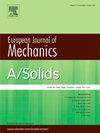Forced vibration characteristics of viscoelastic variable stiffness laminated composite plates using time and frequency domain approaches
Abstract
The linear forced vibration characteristics of viscoelastic variable stiffness laminated composite plates (VVSLC) are studied using a generalized Maxwell model and finite element method. The integral form of the viscoelastic constitutive relation is converted to the incremental form for finite element formulation based on the Reissner–Mindlin plate theory. The recursive relations are developed to compute the current time-step solution using only the previous time-step solution. The periodic response directly in the time domain is obtained using shooting technique coupled with Newmark’s time integration method. The implementation of shooting technique for Boltzmann integral-based viscoelasticity for curvilinear fibre composite plates is done for the first time in this study. For the comparison purpose, the response/resonance frequency/modal loss factor is also obtained using equivalent complex modulus based viscoelastic correspondence principle. It is observed that the variation in fibre orientation and boundary conditions leads to significant variations in response, stress/moment resultant amplitude and the damping factor of the VVSLC plates. Further, the present time domain based approach is capable of predicting damping factor at all forcing frequencies whereas complex eigenvalue analysis can predict damping factor only at discrete resonance frequency. Based on the detailed studies, it is found that the curvilinear fibre composite plates depict a significant reduction in response/moment resultants compared to straight fibre composite plates.

 求助内容:
求助内容: 应助结果提醒方式:
应助结果提醒方式:


